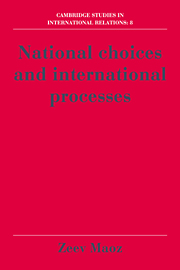Book contents
- Frontmatter
- Contents
- List of figures
- List of tables
- Preface
- 1 Toward a theory of international processes
- 2 Foreign policy decision making: assumptions and characterization of the approach
- 3 The inputs of decision making: identification and conceptualization
- 4 The essential mathematics of inputs
- 5 Models of the decision process
- 6 A formal characterization of decision processes
- 7 A theory of foreign policy decision making
- 8 The analysis of international outcomes
- 9 The evolution of international processes
- 10 Individual preferences, national choices, and international systems
- References
- Name Index
- Subject Index
4 - The essential mathematics of inputs
Published online by Cambridge University Press: 05 February 2012
- Frontmatter
- Contents
- List of figures
- List of tables
- Preface
- 1 Toward a theory of international processes
- 2 Foreign policy decision making: assumptions and characterization of the approach
- 3 The inputs of decision making: identification and conceptualization
- 4 The essential mathematics of inputs
- 5 Models of the decision process
- 6 A formal characterization of decision processes
- 7 A theory of foreign policy decision making
- 8 The analysis of international outcomes
- 9 The evolution of international processes
- 10 Individual preferences, national choices, and international systems
- References
- Name Index
- Subject Index
Summary
INTRODUCTION
This chapter attempts to conceptualize formally the decisionrelated inputs that were discusssed in the previous chapter, and to specify the interrelations among those inputs. This effort is stimulated by three points I raised at the end of chapter 3. First, I attempt to show how the domain of decisional inputs can be made more parsimonious by developing composite measures of seemingly distinct variables. Secondly, I show that these concepts are not only substantively meaningful but also mathematically precise and operationally tractable. Thirdly, I show how these individual level inputs can be transformed into group level inputs.
Three comments about the contents and structure of this chapter are in order. First, the discussion will be purely abstract. I do not go into details regarding operationalization procedures of the various concepts, though the examples I use should give some ideas regarding empirical measurement. To be sure, there are a lot of problems requiring resolution when one transforms purely abstract concepts into empirically observable variables, and I definitely do not wish to ignore them. However, in order not to confuse abstract concepts with their empirical referents, I will stick to mathematics rather than to statistics. The puzzled empiricist is referred to some of my earlier work (Maoz, 1981, 1986) for a discussion and illustration of measurement procedures and solutions to problems of validity and reliability.
- Type
- Chapter
- Information
- National Choices and International Processes , pp. 85 - 148Publisher: Cambridge University PressPrint publication year: 1990

